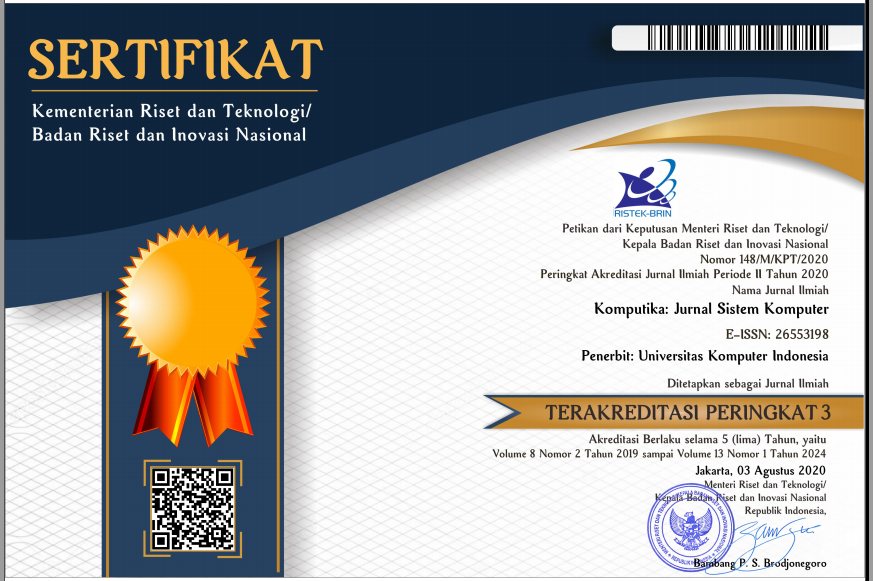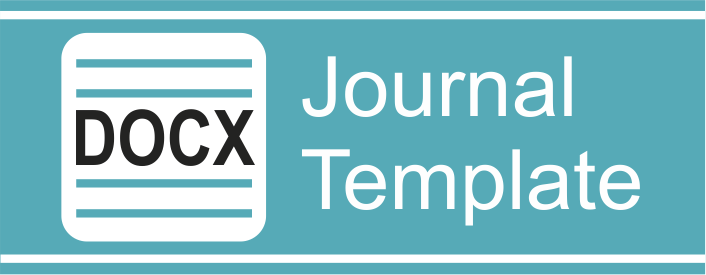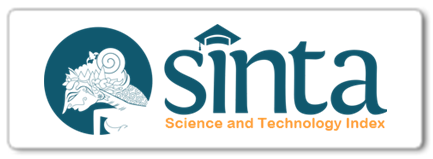Author Guidelines
Panduan bagi Penulis
- Naskah ditulis dalam Bahasa Indonesia atau Bahasa Inggris dan diketik dalam 2 kolom (ukuran kertas A4) dengan huruf Book Antiqua 10, rata kanan-kiri 2.5 cm.
- Naskah diawali dengan judul (maks. 14 kata), nama penulis (tanpa gelar), instansi dan alamat email untuk korespondensi. Isi naskah setidak-tidaknya berisi/menerangkan tentang pendahuluan, metoda, hasil diskusi, kesimpulan, daftar pustaka. Ucapan terima kasih bila diperlukan dapat dituliskan setelah bagian kesimpulan.
- Naskah dilengkapi dengan abstrak (100-150 kata) yang ditulis dalam bahasa Indonesia dan Bahasa Inggris, masing-masing diikuti dengan kata kunci (5 kata). Abstrak hendaknya menjelaskan tentang apa yang diteliti/dikembangkan/dipikirkan, metoda dan hasil sehingga isi naskah dapat tergambar tanpa membaca seluruh tulisan.
- Judul bagian naskah serta sub judul untuk bagian berbeda (pendahuluan, metoda, hasil, diskusi, kesimpulan) diberikan nomor arab (1, 2, ..., dst)
- Satuan ukuran yang digunakan serta singkatannya mengikuti aturan International System of Units (SI).
- Persamaan dinomori berurutan dengan nomor arab dalam kurung di sebelah kanan persamaan (rata kanan). Penggunaan simbol dalam persamaan diberi keterangan dalam bagian naskah di bawahnya.
- Penyisipan gambar dan tabel disertai dengan j udul singkat di bawahnya (untuk gambar) dan di atasnya (untuk tabel) serta diberi nomor berurutan. Seluruh gambar dan tabel yang digunakan harus diulas pada bagian tulisan.
- Daftar referensi yang dikutip dituliskan pada bagian akhir naskah dengan memberikan nomor urut sesuai dengan urutan pengutipan pada naskah, dengan ketentuan min. referensi adalah 15 referensi (80% berupa jurnal dengan keterbaruan 10 tahun terakhir).
- Contoh penulisan referensi adalah sebagaimana berikut:
Daftar Pustaka
[1] K. Chen, Linear Networks and Systems. Belmont, CA: Wadsworth, 1993, pp. 123-135.
[2] The Oxford Dictionary of Computing, 5th ed. Oxford: Oxford University Press, 2003.
[3] Bass, P. Clements, and R. Kazman, Software Architecture in Practice, 2nd ed. Reading, MA: Addison Wesley, 2003. [E-book] Available: Safari e-book.
[4] D. Lipson and B. D. Horwitz, “Photosensory reception and transduction,†in Sensory Receptors and Signal Transduction, J. L. Spudich and B. H. Satir, Eds. New York: Wiley-Liss, 2001, pp-1-64.
[5] B. R. Strimpel, "Computer graphics," in McGraw-Hill Encyclopedia of Science and Technology, 8th ed., Vol. 4. New York: McGraw-Hill, 1997, pp. 279-283.
[6] Altun, “Understanding hypertext in the context of reading on the web: Language learners’ experience,†Current Issues in Education, vol. 6, no. 12, July, 2005. [Online]. Available: http://cie.ed.asu.edu/volume6/number12/.[Access-ed Dec. 2, 2007].
[7] Ayasso and A. Mohammad-Djafari, "Joint NDT Image Restoration and Segmentation Using Gauss–Markov–Potts Prior Models and Variational Bayesian Computation," IEEE Transactions on Image Processing, vol. 19, no. 9, pp. 2265-77, 2010. [Online]. Available: IEEE Xplore, http://www.ieee.org. [Accessed Sept. 10, 2010].
[8] Chen, W. Huang, B. Zhou, C. Liu, W.H. Mow, "PiCode: a new picture-embedding 2D barcode", IEEE Transactions on Image Processing, vol. 25, no. 8, pp. 3444-3458, August 2016.
[9] Bánoci, M. Broda, G. Bugár, D. Levický, "Universal Image Steganalytic Method", In: Radioengineering, vol. 23, no. 4, pp. 1213-1220, December 2014, ISSN 1210-2512.
[10] Smith, R. Jones, and K. Trello, “Adaptive filtering in data communications with self improved error reference,†In Proc. IEEE International Conference on Wireless Communications ’04, 2004, pp. 65-68.
[11] Liu and H. Miao, "A specification based approach to testing polymorphic attributes," in Formal Methods and Software Engineering: Proc.of the 6th Int. Conf. on Formal Engineering Methods, ICFEM 2004, Seattle, WA, USA, November 8-12, 2004, J. Davies, W. Schulte, M. Barnett, Eds. Berlin: Springer, 2004. pp. 306-19.
[12] Lach, "SBFS: Steganography based file system," in Proc. of the 2008 1st Int. Conf. on Information Technology, IT 2008, 19-21 May 2008, Gdansk, Poland [Online]. Available: IEEE Xplore, http://www.ieee.org. [Accessed: 10 Sept. 2010].
[13] A. Nimr, "Defuzzification of the outputs of fuzzy controllers," presented at 5th Int. Conf. on Fuzzy Systems, 1996, Cairo, Egypt. 1996.
[14] Kimura and A. Lipeles, “Fuzzy controller component,†U. S. Patent 14, 860,040, 14 Dec., 2006.
[15] Texas Instruments, “High speed CMOS logic analog multiplexers/demultiplexers,†74HC4051 datasheet, Nov. 1997 [Revised Sept. 2002].
[16] European Telecommunications Standards Institute, “Digital Video Broadcasting (DVB): Implementati-on guidelines for DVB terrestrial services; transmission aspects,†European Telecommuni-cations Standards Institute, ETSI TR-101-190, 1997. [Online]. Available: http://www.etsi.org. [Accessed: Aug. 17, 1998].
[17] Sussman, "Home page - Dr. Gerald Sussman," July 2002. [Online]. Available: http:// www.comm.pdx.edu/faculty/Sussman/sussmanpage.htm. [Accessed: Sept. 12, 2004].
[18] Karnik, “Performance of TCP congestion control with rate feedback: TCP/ABR and rate adaptive TCP/IP,†M. Eng. thesis, Indian Institute of Science, Bangalore, India, Jan. 1999.
[19] Sudweeks, Development and Leadership in Computer-Mediated Collaborative Groups. PhD [Dissertation]. Murdoch, WA: Murdoch Univ., 2007. [Online]. Available: Australasian Digital Theses Program.
[20] Padhye, V. Firoiu, and D. Towsley, “A stochastic model of TCP Reno congestion avoidance and control,†Univ. of Massachusetts, Amherst, MA, CMPSCI Tech. Rep. 99-02, 1999.
[21] Wireless LAN Medium Access Control (MAC) and Physical Layer (PHY) Specification, IEEE Std. 802.11, 1997.


















